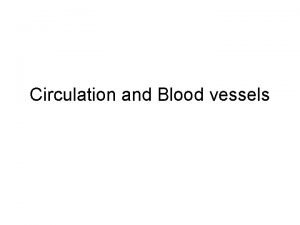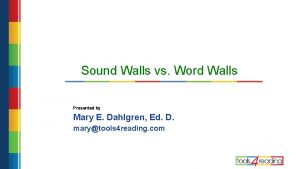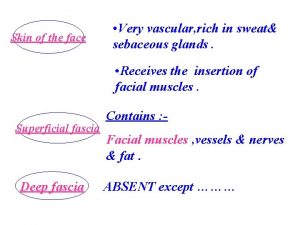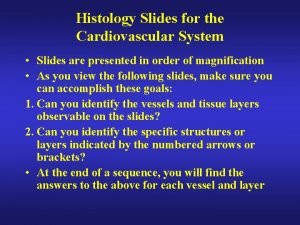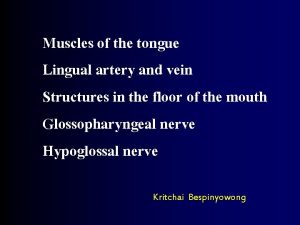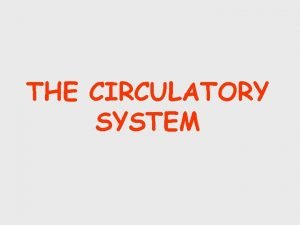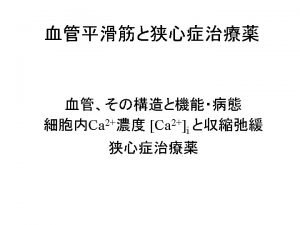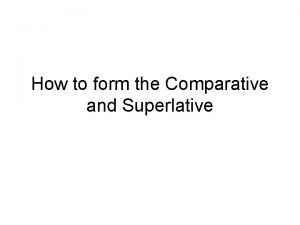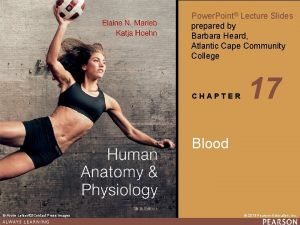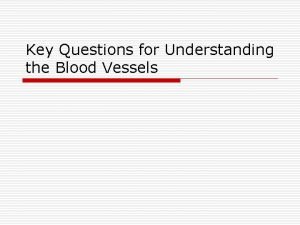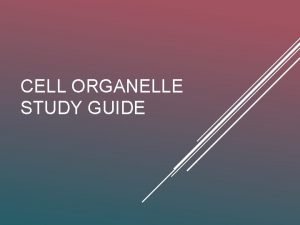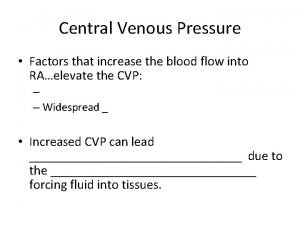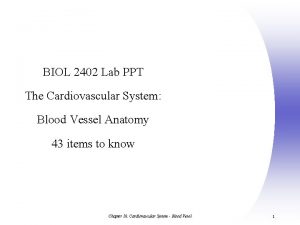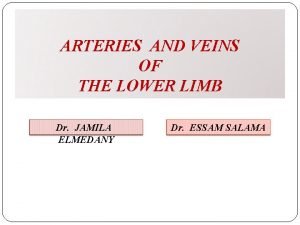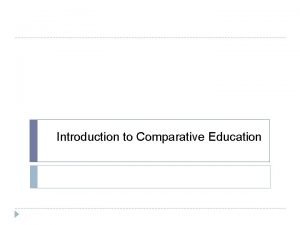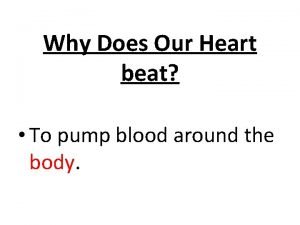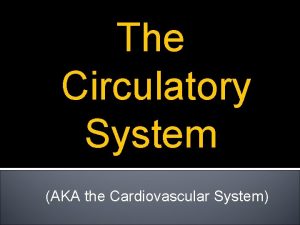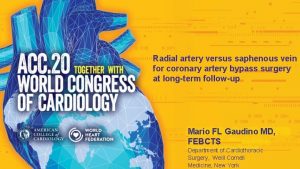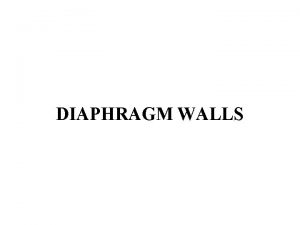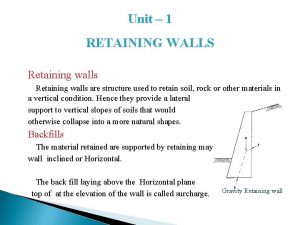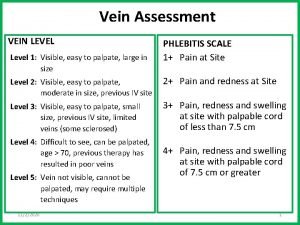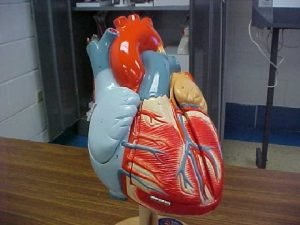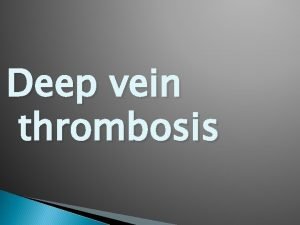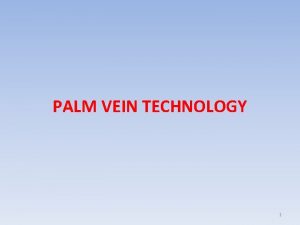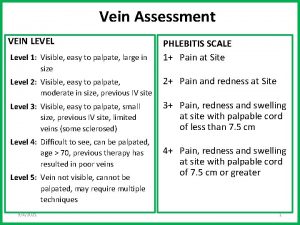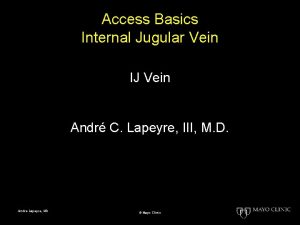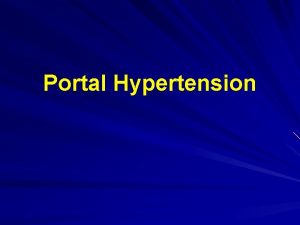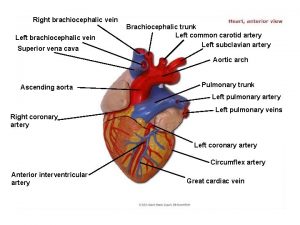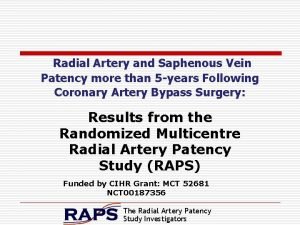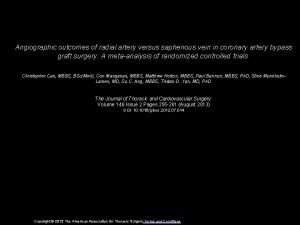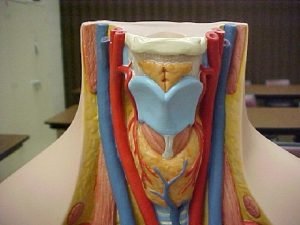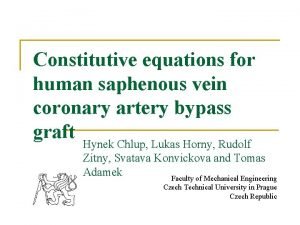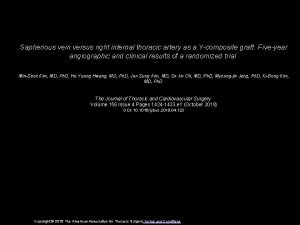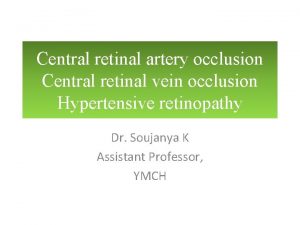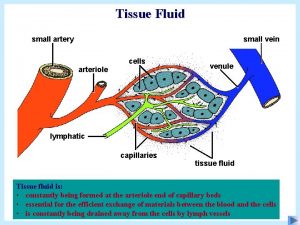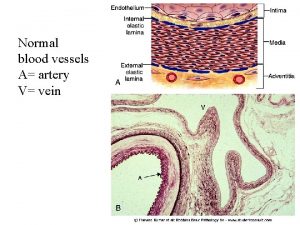Comparative Structure of Artery and Vein Vessel Walls






























- Slides: 30

Comparative Structure of Artery and Vein Vessel Walls • Arteries: 1. Tunica Interna a. Endothelium b. Basement membrane c. Internal elastic lamina 2. Tunica Media a. Smooth muscle b. External elastic lamina 3. Tunica Externa a. Connective tissue

Comparative Structure of Artery and Vein Vessel Walls • Veins: 1. Tunica Interna a. Endothelium b. Basement membrane 2. Tunica Media a. Smooth Muscle 3. Tunica Externa a. Connective Tissue • Capillary a. Endothelium b. Basement membrane

Classification of Arteries • Elastic Arteries (Conducting arteries) Aorta, Brachiocephalic, Common Carotid, Subclavian, Vertebral, Pulmonary, Common Iliac • Muscular Arteries (Distributing Arteries) Brachial artery, Radial artery, Popliteal, Common Hepatic

Circulation Through a capillary bed • Arterioles: deliver blood to capillaries • Metarterioles: emerges from arterioles and supplies a group of capillaries • Thoroughfare Channel: arise from metarterioles and contain no smooth muscle. Thoroughfares allow blood to bypass the capillary

Different types of Capillaries • Continuous Capillaries Plasma membranes of endothelial cells form a continuous tube only interrupted by intercellular clefts (gaps between cells) (lungs and muscle) • Fenestrated Capillaries Plasma membrane of endothelial cells contain pores or fenestrations (Kidney and villi of small intestines)

Different types of Capillaries • Sinusoids: Wider and more winding than other capillaries, with incomplete basement membranes and large fenestrations (red bone narrow and liver)

Blood distribution in the Cardiovascular System

Mechanisms of Capillary Exchange • Simple Diffusion: (CO 2, glucose, amino acids, and hormones) • Transcytosis: Substances enter lumen side of endothelial cells via endocytosis and exit the other side via exocytosis • Bulk Flow: Substances dissolved in fluid are moved in the same direction as the fluid

Forces involved in Capillary Exchange

Factors that Affect Capillary Exchange • Edema = increased Interstitial Fluid 1. Increased BHP a. increased CO b. increased blood volume 2. Increased Permeability of Capillaries a. Increased IFOP b. Bacteria c. Tissue damage

Factors that Affect Capillary Exchange • Edema = increased Interstitial Fluid 3. Decreased reabsorption a. Decreased BCOP: liver disease, burns, kidney disease b. Lymphatic blockage: cancer and parasites

Elephantiasis: is a rare disorder of the lymphatic system caused by parasitic worms such as Wuchereria bancrofti, Brugia malayi, and B. timori, all of which are transmitted by mosquitoes. Inflammation of the lymphatic vessels causes extreme enlargement of the affected area, most commonly a limb or parts of the head and torso. It occurs most commonly in tropical regions and particularly in parts of Africa.




Factors That Affect Circulation • Velocity of Blood: 1. Measured as the volume of blood that flows through any tissue in a given time period. 2. Velocity is inversely related to cross-sectional area Aorta: 3 -5 cm 2, 40 cm/sec Capillaries: 4, 500 -6, 000 cm 2/ 0. 1 cm/sec Vena Cavas: 14 cm 2, 520 cm/sec

Factors That Affect Circulation • Resistance: Measured as the opposition to blood flow through blood vessels due to friction between the blood and vessel walls. 1. Average vessel radius: Resistance is inversely proportional to the fourth power of the radius 2. Blood viscosity: Resistance is directly proportional to viscosity 3. Total vessel length: Resistance is directly proportional to vessel length

Factors That Affect Circulation • Volume of Blood Flow: Measured by Cardiac Output CO = SV x HR • Blood Pressure: Measured as the hydrostatic pressure exerted on vessel walls by the blood Young Adult: 120/80 120 = ventricular systole 80 = ventricular diastole Mean arterial blood pressure: MABP = diastolic BP + 1/3[Pulse Pressure (PP)] PP = (systolic BP – diastolic BP)

Factors That Affect Circulation • Cardiac Output is directly related to blood pressure CO = MABP/R R= Resistance

Relationship between Blood Pressure, Cuff Pressure, and Korotkoff Sounds • Blood Pressure is measured in the Brachial Artery using a Sphygmomanometer • As cuff pressure drops to a point where it equals systolic pressure, the first Korotkoff sound is heard • As cuff pressure continues to drop to the point where it equals diastolic pressure, the last Korotkoff sound is heard • Blood pressure is recorded as the first sound (systolic) and the last sound (diastolic) pressure

Action of Skeletal Muscle in Venous Return • While standing at rest, venous valves are open • Contraction of muscles pushes blood upward through the proximal valve, back-pressure closes the distal valve • As muscle relaxes, pressure drops closing the proximal valve. Higher blood pressure in the foot opens the distal valve allowing blood to flow into section of the vein.

Summary of Factors that Increase Blood Pressure

Overview of Hormones that Regulate Blood Pressure 1. Cardiac Output: Increased CO = Increased BP Increased CO and contractility Epinephrine from Adrenal Medulla Norepinephrine from sympathetic neurons

Overview of Hormones that Regulate Blood Pressure • Systematic Vascular Resistance 1. Vasoconstriction (increased) a. Angiotensin II b. ADH (vasopressin) c. Epinephrine d. Norepinephrine 2. Vasodilation (decreased) a. ANP b. Epinephrine c. Nitric Oxide

Overview of Hormones that Regulate Blood Pressure • Blood Volume 1. Increased a. Aldosterone b. ADH 2. Decreased a. ANP

Hypovolemic Shock • Due to decreased blood volume • Stages of shock Stage 1: compensated or nonprogressive Stage 2: decompensated or progressive (up to 25% loss) Stage 3: irreversible shock (death)

Hypovolemic Shock Stage 1: compensated or non-progressive a. Activation of the sympathetic nervous system b. Activation of the renin-angiotensin pathway c. Release of ADH d. Signs of clinical hypoxia Stage 2: Decompensated or progressive (up to 25% loss) a. Depressed cardiac activity (MABP as low as 60) b. Depressed vasoconstriction (MABP as low as 40) c. Increased capillary permeability d. Intravascular clotting e. Cellular death occurs e. Respiratory acidosis

Negative Feedback Response to Hypovolemic Shock

CNS Input and Regulation of Cardiac Activity

ANS Regulation of Cardiac Activity
 Artery vein capillary structure
Artery vein capillary structure I build walls walls that protect
I build walls walls that protect Sound word wall
Sound word wall Tunica media
Tunica media Facial vein
Facial vein Vein vs artery microscope
Vein vs artery microscope Vena com n hypoglossi
Vena com n hypoglossi Difference between arteries and veins in tabular form
Difference between arteries and veins in tabular form Branches of sma
Branches of sma Structure of an artery
Structure of an artery Comparative form.
Comparative form. Starbourd
Starbourd What is one part of a regular vessel and engine maintenance
What is one part of a regular vessel and engine maintenance Two types of wbc
Two types of wbc These vessels have thicker walls and a heavier tunica media
These vessels have thicker walls and a heavier tunica media Ceiling finishing materials
Ceiling finishing materials Cell organelle study guide
Cell organelle study guide Advantages and disadvantages of hard engineering
Advantages and disadvantages of hard engineering When evaluating the floors walls and ceilings
When evaluating the floors walls and ceilings Great and small saphenous vein
Great and small saphenous vein Dorsalis pedis vein
Dorsalis pedis vein ชนิดของหลอดเลือด
ชนิดของหลอดเลือด Posterior tibial pulse landmark
Posterior tibial pulse landmark Definition of comparative education
Definition of comparative education Casual comparative vs. comparative
Casual comparative vs. comparative Blood vessel adaptations
Blood vessel adaptations Vessel examiner test answers
Vessel examiner test answers Smallest blood vessel
Smallest blood vessel 3 main parts of circulatory system
3 main parts of circulatory system Towing tunica
Towing tunica Stern landing vessel
Stern landing vessel
